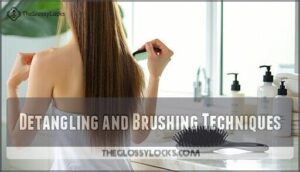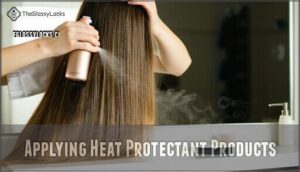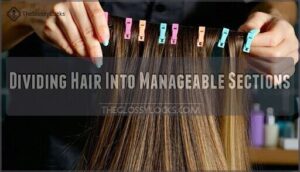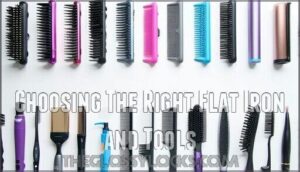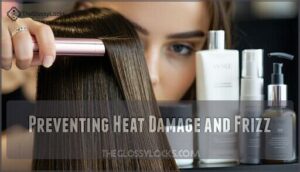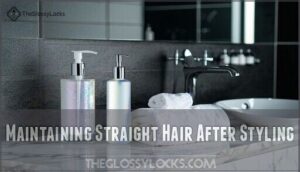This site is supported by our readers. We may earn a commission, at no cost to you, if you purchase through links.
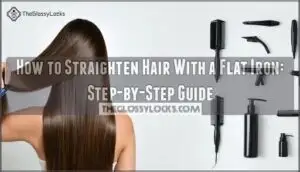
The difference between salon-smooth hair and a frizzy mess comes down to technique—how you prep, section, and glide the iron matters more than the tool itself. Getting it right means understanding your hair’s needs, choosing the proper temperature, and moving with intention rather than speed.
Master these fundamentals, and you’ll transform your routine from frustrating guesswork into consistent, damage-free results that actually last.
Table Of Contents
- Key Takeaways
- How to Straighten Hair With a Flat Iron
- Preparing Your Hair for Flat Ironing
- Choosing The Right Flat Iron and Tools
- Preventing Heat Damage and Frizz
- Maintaining Straight Hair After Styling
- Frequently Asked Questions (FAQs)
- How do I know if my hair is suitable for straightening?
- Is there a way to reduce the time it takes to straighten my hair?
- What are the pros and cons of using a flat iron?
- How often should I use a flat iron to straighten my hair?
- How often can I straighten hair safely?
- Can I straighten damp or towel-dried hair?
- Does hair type affect straightening time needed?
- Should I straighten hair before or after cutting?
- Can I swim after straightening my hair?
- Conclusion
Key Takeaways
- Straightening hair successfully depends on proper preparation—completely dry hair, heat protectant application, and strategic sectioning into 1-2 inch pieces—more than the flat iron itself.
- Temperature selection must match your hair type (250-300°F for fine hair, 350-400°F for coarse hair) to prevent damage while achieving sleek results with minimal repeat passes.
- Technique matters more than speed—start at the roots, use consistent pressure, glide in one smooth motion without stopping, and let each section cool completely before touching it.
- Protection extends beyond styling through finishing sprays for humidity resistance, silk wraps for overnight care, and limiting straightening to 2-3 times weekly to maintain hair health.
How to Straighten Hair With a Flat Iron
Straightening your hair with a flat iron isn’t just about running hot plates through your strands and hoping for the best. You need the right approach to get salon-smooth results without frying your hair.
Here’s how to master the technique step by step.
Step-by-Step Straightening Process
Mastering the flat iron isn’t rocket science—it’s all about following the right sequence, staying patient, and letting the tool do the heavy lifting.
Start at the roots, clamp down with consistent pressure, and glide the iron slowly in one smooth motion from root to tip. Don’t overlap sections—you’re straightening, not scorching—and resist the urge to rush.
Sectioning Hair for Best Results
Before you even pick up the flat iron, you need to break your hair down into sections—1 to 2 inches wide—or you’ll end up with wonky, half-straight strands that’ll have you starting from scratch.
Use clips to separate your hair into manageable layers, working from the bottom up. Thicker hair needs smaller sections for even heat distribution, while finer textures can cope with slightly wider chunks.
This sectioning pattern keeps your straightening technique consistent and helps you achieve symmetry without missing spots or overworking strands.
Proper Motion and Technique
Once your sections are clipped and ready, the way you glide that flat iron down each strand will make or break your results. Start at the roots—get close without burning your scalp—then clamp down with consistent pressure and pull through in one fluid motion. Don’t stop midway or you’ll create creases.
Controlled passes mean fewer repeat runs and less heat exposure, so move steadily but deliberately, letting the plates do the work without overlapping sections.
Tips for Even, Sleek Results
To nail that salon-smooth finish, you’ll want to fine-tune a few habits that separate okay results from the kind of sleekness that turns heads.
- Maintain consistent pressure through each pass so your flat iron grips every strand evenly.
- Keep section size between one and two inches for thorough coverage without overlap.
- Control your iron speed—move steadily but not too fast.
- Start at the root and glide down without stopping to avoid creases.
Preparing Your Hair for Flat Ironing
Proper preparation is the foundation of smooth, sleek hair that lasts all day. Before you even pick up your flat iron, you’ll need to set yourself up for success by getting your hair in the right condition.
Here’s what you need to do to protect your strands and achieve salon-worthy results.
Washing and Drying Your Hair
Start with freshly washed hair—think of it as a blank canvas where heat styling can work its magic without fighting through buildup or oils. Use a gentle shampoo and lightweight conditioner that won’t weigh your strands down.
After towel drying, grab your hair dryer and blow-dry completely on a low heat setting—skipping air drying ensures your flat iron glides smoothly instead of wrestling with damp spots that refuse to straighten.
Detangling and Brushing Techniques
Before you even think about heat, run a wide-tooth comb gently through your hair from ends to roots—forcing through knots is a one-way ticket to breakage and uneven straightening.
Once detangled, switch to a paddle brush for smoothing, working methodically through each section. This gentle detangling routine prevents snags during flat ironing and creates the perfect foundation for sleek, even results.
Applying Heat Protectant Products
Think of heat protectant as your hair’s armor against the scorching plates—skip this step, and you’re basically inviting split ends and frizz to the party.
Heat protectant isn’t optional—skip it, and you’re inviting split ends and frizz to wreck your hair
Spray a thermal heat protectant evenly through damp or dry hair, holding the bottle six inches away, then comb it through for complete coverage.
Look for products with silicones or keratin that shield each strand from heat damage—your hair will thank you later.
Dividing Hair Into Manageable Sections
Sectioning your hair isn’t just a suggestion—it’s the difference between walking out with sleek, salon-worthy hair and a frizzy, half-straightened mess.
Divide your hair into one to two-inch sections using clips, working from the bottom layer up—thicker hair needs smaller sections for even heat distribution, while preparing hair for straightening means thinking about symmetry from the start.
Choosing The Right Flat Iron and Tools
Not all flat irons are created equal, and the right tools can make or break your straightening routine. From plate materials to temperature controls, each feature plays a specific role in protecting your hair while delivering sleek results.
Here’s what you need to know before you plug in and heat up.
Ceramic Vs. Titanium Vs. Tourmaline Plates
Choosing the right flat iron isn’t about chasing expensive brands—it’s about matching plate material to your hair’s needs. Ceramic flat irons deliver even heat conductivity for fine to medium hair, making them a solid starting point. Titanium plates heat faster and manage thick, coarse textures with ease, though they require careful temperature control.
Tourmaline plates emit negative ions that tame frizz, ideal for damaged or color-treated hair straightening while extending plate durability without breaking your budget. For best results, consider that titanium plates offer faster heat transfer.
Selecting The Proper Plate Size
Plate width isn’t just a technical detail—it’s the difference between spending twenty minutes or two hours fighting with your flat iron. Match your choice to your hair’s reality:
- Narrow plates (¾-1 inch) work for short hair, bangs, and precision work around your face without the iron weight dragging you down.
- Medium plates (1-1.5 inches) offer styling versatility for shoulder-length hair and mixed hair thickness.
- Wide plates (1.5-2 inches) power through long, thick hair length in fewer passes, though they sacrifice control on shorter sections.
Adjustable Temperature Settings
Your flat iron needs the right temperature dial, or you’ll either scorch your strands or waste time re-passing sections that won’t cooperate. Temperature control matters because different hair types need different heat levels—fine hair straightens at 250-300°F, while thick or coarse textures require 350-400°F for consistent heat distribution.
Using a flat iron without proper heat setting risks serious heat damage, so choose a model with adjustable controls to match your hair’s needs and prevent unnecessary strand stress.
Essential Styling Accessories (Clips, Brushes, Combs)
Once you’ve dialed in the perfect temperature, you’ll need a few key tools to section, grip, and guide your hair through the straightening process without fighting flyaways or losing control.
Sectioning clips hold hair sections out of your way while you work, and a heat-resistant comb helps detangle without melting.
Choose a paddle brush for smoothing larger sections and a fine-tooth comb for precision parting—these hair styling tools give you the control to execute clean hair sectioning techniques.
Preventing Heat Damage and Frizz
Heat damage and frizz can turn your sleek straightening session into a disaster, but they’re completely preventable with the right approach. The key lies in understanding how to protect your hair before, during, and after you pick up that flat iron.
Let’s break down the essential steps that’ll keep your strands smooth, shiny, and healthy.
Setting The Correct Flat Iron Temperature
If you’ve ever watched your carefully straightened hair turn into a frizzy mess halfway through styling, the culprit might be the temperature dial staring you in the face. Getting temperature control right means matching your heat setting to your hair type and texture—not just cranking it up and hoping for the best. Here’s your damage threshold guide:
- Fine or damaged hair: Stick between 250-300°F to avoid crossing your hair’s damage threshold while still achieving sleekness.
- Medium hair texture: The ideal range sits around 300-350°F, where most iron materials deliver excellent heat recovery without over-processing.
- Coarse or thick hair: You’ll need 350-400°F in temperature increments, but never exceed 450°F regardless of hair type—that’s where heat damage becomes inevitable.
Importance of Heat Protectant Sprays
Heat protectant sprays aren’t optional—they’re your first line of defense against thermal damage. These thermal heat protectant formulas create a barrier that can reduce breakage by up to 50% and improve moisture retention by 20-35%. The protection mechanisms involve silicones and polymers that insulate your hair shaft, limiting direct heat contact while enhancing appearance with smoother, shinier results.
With product innovations driving market growth, you’ve got options from natural formulas to micro-encapsulated actives that deliver lasting hair heat protection. Excessive heat can lead to noticeable hair damage, so protection is key.
Avoiding Common Heat Styling Mistakes
Even seasoned flat iron users slip into habits that sabotage their results—and most don’t realize it until the damage is done. Overlapping passes on the same section, working with wet hair, or cranking up high temperatures without protection are classic traps.
Uneven sections also cause trouble—preventing hair damage starts with consistent technique and proper hair heat protection, not just the right tools.
Post-Straightening Cooling and Care
After the last pass of your flat iron, resist the urge to touch, style, or pin your hair—those strands need time to lock in their new shape. The hair cooling process is essential for lasting hair smoothness and shine. Let each section cool completely before moving forward with finishing hair styling:
- Wait 5-10 minutes for the cooling duration before applying finishing products
- Use humidity protection serums to shield against moisture in the air
- Plan nighttime care routines to minimize reapplication needs and preserve your work
Maintaining Straight Hair After Styling
You’ve put in the work to get your hair perfectly straight, but now comes the real challenge—keeping it that way. From finishing products to storage tips, a few smart moves will help you maintain that sleek look longer.
Here’s what you need to know to protect your style and your flat iron.
Using Finishing Sprays for Hold and Protection
Think of finishing spray as the final lock on a vault—it seals in all the hard work you’ve just put into straightening your hair. Look for spray ingredients like polymers that boost humidity resistance and add shine enhancement without weighing down your strands.
Apply it from about ten inches away, using light sweeping motions rather than saturating one spot. A light-hold finishing spray protects against hair humidity and frizz while keeping your style flexible and touchable.
Keeping Hair Straight in Humid Conditions
Humidity is hair straightening’s toughest opponent, but you can win this battle. Layer anti-humidity products like humidity-resistant serums or antifrizz serum to create a barrier against moisture that triggers hair frizz. For extended humidity protection, consider keratin treatments that restructure strands from within.
Before bed, use overnight protection methods like protective hairstyles (loose buns or silk wraps) to maintain your sleek look while you sleep, keeping hair humidity at bay.
Cleaning and Storing Your Flat Iron
Your flat iron works hard for you, and a quick wipe-down after every few uses keeps it performing like new. Once cooled completely, use a damp cloth to remove plate buildup from hair styling products.
Store your flat iron in a heat-resistant pouch with proper cord management—never wrap cords tightly around hot plates.
For travel storage, invest in a protective case that shields plates and prevents hair care disasters in your luggage.
Daily Care Tips for Lasting Sleekness
Keeping your freshly straightened hair sleek beyond day one means treating it like silk between styling sessions.
Wrap your hair in silk scarves at night to protect against friction, and stick to gentle brushing with a wide-tooth comb. Skip the daily wash—minimal washing preserves your hair’s natural shine and extends your style.
Use hydrating products sparingly to maintain your hair care routine without weighing down strands.
Frequently Asked Questions (FAQs)
How do I know if my hair is suitable for straightening?
Almost all hair types can withstand straightening, but success depends on your hair texture, damage level, and heat sensitivity. Previously treated or chemically processed hair needs extra care.
Assess your hair’s health and resistance before applying high heat to avoid further damage.
Is there a way to reduce the time it takes to straighten my hair?
Absolutely. Larger sections speed things up—go for two-inch pieces instead of one. Crank up your heat settings if your hair can withstand it, use a quality flat iron with fast heat recovery, and nail your hair prep with a solid thermal heat protectant so you’re not making multiple passes.
What are the pros and cons of using a flat iron?
Before telegraphs made instant communication possible, mastering a flat iron meant everything for daily convenience and styling versatility. The pros? Cost effectiveness and transforming any texture instantly. The cons? Potential damage from heat and the time commitment required.
Protecting hair from heat preserves hair health during hair straightening.
How often should I use a flat iron to straighten my hair?
Frequency depends on your hair type and damage assessment. For healthy hair, 2-3 times weekly works, but damaged hair needs breaks.
Protective measures and hydration importance mean alternating with alternative styles prevents hair damage while protecting hair from heat and maintaining hair health.
How often can I straighten hair safely?
Most people can safely straighten hair two to three times weekly, depending on hair texture and heat tolerance.
Use protective products, assess for damage regularly, and prioritize hydration importance to prevent heat styling harm through proper hair damage prevention practices.
Can I straighten damp or towel-dried hair?
No—never straighten damp or towel-dried hair. Water vaporization from applying heat to hair causes severe damage as steam literally fries strands from within.
Hair preparation steps require complete dryness before flat iron use, protecting hair porosity and preventing irreversible harm through proper hair damage prevention techniques.
Does hair type affect straightening time needed?
Like a marathon runner versus a sprinter, different hair types demand different time on the track. Hair texture, thickness, and porosity all influence heat tolerance and straightening speed—coarse, dense hair needs more passes and higher temperatures, while fine hair smooths quickly with minimal heat.
Should I straighten hair before or after cutting?
Cut first, then straighten. Cutting pre-straightening leads to length accuracy issues since curly hair appears shorter. Straightening after-cut allows proper style refinement without cut-induced damage from unnecessary heat exposure.
This hair straightening technique ensures precise results using a flat iron effectively.
Can I swim after straightening my hair?
Swimming right after straightening isn’t ideal. Pool chemicals and saltwater strip hair moisture, causing frizz and undoing your sleek style.
Wait at least 24 hours, or use protective hairstyles like braids.
Post-swim care requires chlorine removal tips to restore hair protection.
Conclusion
Perfect hair doesn’t happen by accident—it’s the result of intentional choices made before, during, and after you pick up that iron. You’ve learned how to straighten hair with a flat iron through proper prep, smart sectioning, and controlled heat application.
Now it’s about consistency. Keep your tools clean, respect your hair’s limits, and trust the process. When technique replaces guesswork, those salon-quality results become your new baseline—not a lucky break.
- https://www.healthline.com/health/beauty-skin-care/types-of-hair
- https://dataintelo.com/report/global-heat-protection-spray-market
- https://www.linkedin.com/pulse/in-depth-heat-protection-spray-market-analysis-projected-98-cagr-nnwne
- https://colorwowhair.com/blogs/all/heat-damaged-hair-heat-protectant
- https://www.livingproof.com/blogs/hair-101/does-heat-protectant-spray-work


